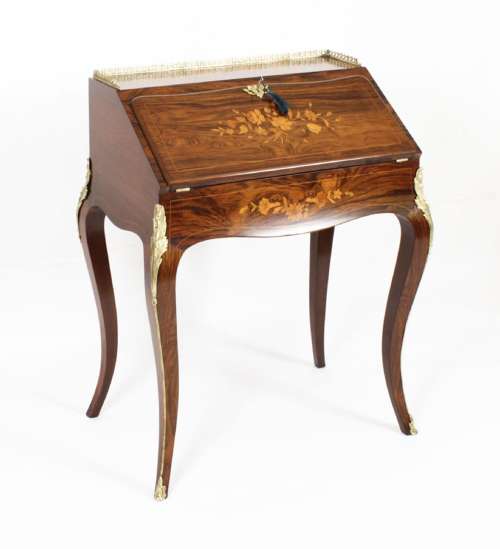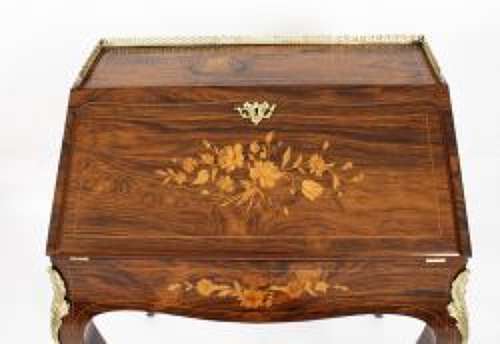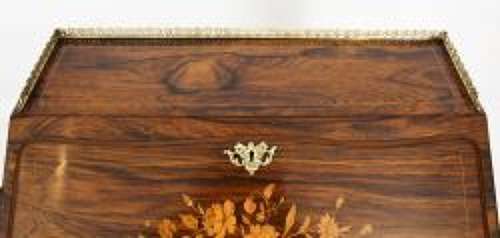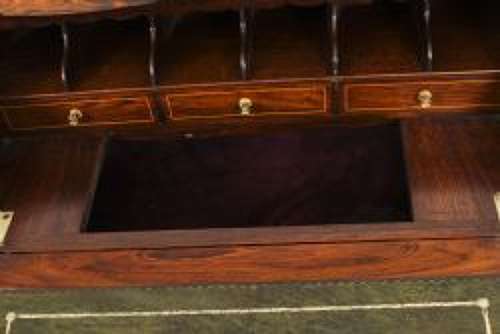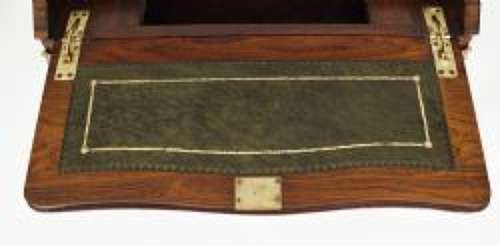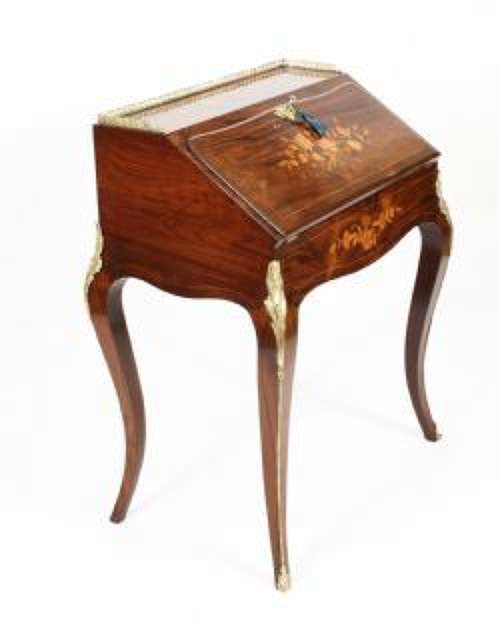Antique French Gonalo Alves Marquetry Bureau De Dame 19th C
Delivery Quote Request
Please fill in the form below to request a delivery quote from Regent Antiques.
Contact Regent Antiques
 London, United Kingdom
London, United Kingdom
Simply fill in the below form to get in touch with Regent Antiques regarding this item.
About this item
This is an elegant antique French Louis Revival ormolu mounted Gonalo Alves bureau de dame, dating from Circa 1860.
The fall front features floral marquetry decoration and opens to reveal a fitted interior with a six pigeon holes, three small drawers and an inset green leather writing surface. The bureau is raisedon elegant ormolu mounted cabriole legs.
Add a touch of unparalleled elegance to your home.
Condition:
In really excellent condition having been beautifully cleaned, polished and waxed in our workshops, please see photos for confirmation.
Dimensions in cm:
Height 95 x Width 75 x Depth 50
Dimensions in inches:
Height 3 feet, 1 inch x Width 2 foot, 5 inches x Depth 1 foot, 8 inches
Gonalo Alves is a hardwood (from the Portuguese name, Gonalo Alves). It is sometimes referred to as tigerwood a name that underscore the woods often dramatic, contrasting color scheme.
While the sapwood is very light in color, the heartwood is a sombre brown, with dark streaks that give it a unique look. The woods color deepens with exposure and age and even the plainer-looking wood has a natural luster.
Two species are usually listed as sources for gonalo alves: Astronium fraxinifolium and Astronium graveolens, although other species in the genus may yield similar wood; the amount of striping that is present may vary.
In the high tropical forests of Central and South America, well-drained soils furnish nutrients for a variety of dense, durable hardwoods sought for maritime use, heavyconstruction, and furniture. The Spanish began harvesting in Latin American forests in the early 1500s to provide timber for boatbuilding and repair. By the early 1900s, however, steel ships had replaced wooden ones, and the interest in tropical forests by both Europeans and Americans shifted to appearance-grade woods for furniture.
Although history fails to provide us with a shopping list of species from either harvest period, it's probable that the wood we know today as goncalo alves has always been sought. That's because goncalo alves, considered one of the most beautiful of tropical woods, has a tough reputation, too. Strong and durable, it's used for construction in its homeland and secondarily for fine furniture. Woodworkers elsewhere treasure the wood for decorative items and veneer accents.
Marquetry
is decorative artistry where pieces of material of different colours are inserted into surface wood veneer to form intricate patterns such as scrolls or flowers.
The technique of veneered marquetry had its inspiration in 16th century Florence. Marquetry elaborated upon Florentine techniques of inlaying solid marble slabs with designs formed of fitted marbles, jaspers and semi-precious stones. This work, called opere di commessi, has medieval parallels in Central Italian "Cosmati"-work of inlaid marble floors, altars and columns. The technique is known in English as pietra dura, for the "hardstones" used: onyx, jasper, cornelian, lapis lazuli and colored marbles. In Florence, the Chapel of the Medici at San Lorenzo is completely covered in a colored marble facing using this demanding jig-sawn technique.
Techniques of wood marquetry were developed in Antwerp and other Flemish centers of luxury cabinet-making during the early 16th century. The craft was imported full-blown to France after the mid-seventeenth century, to create furniture of unprecedented luxury being made at the royal manufactory of the Gobelins, charged with providing furnishings to decorate Versailles and the other royal residences of Louis XIV. Early masters of French marquetry were the Fleming Pierre Golle and his son-in-law, Andr-Charles Boulle, who founded a dynasty of royal and Parisian cabinet-makers (bnistes) and gave his name to a technique of marquetry employing brass with pewter in arabesque or intricately foliate de
Internal Ref:
A3255
Date of manufacture : 19th Century
Additional Information
978044 (AB-182441)
W: 75cm (29.5")H: 95cm (37.4")D: 50cm (19.7")
19th Century
![]() London, United Kingdom
London, United Kingdom
Regent Antiques was established in 1980. Born out of a natural love for art and beautiful objects, we have been a highly respected member of the antique fraternity ever since. Industry bodies of which we are a member include LAPADA and CINOA. Over the decades our business has gradually evolved...


